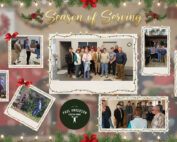“Then Simeon blessed them and said to Mary, his mother: ‘This child is destined to cause the falling and rising of many in Israel, and to be a sign that will be spoken against, so that the thoughts of many hearts will be revealed. And a sword will pierce your own soul too.’ Luke 2:34-35
Stobi is an ancient Roman city located on the trade route that linked the Danube to the Aegean Sea, being currently excavated in Macedonia. I had the privilege of walking through the archaeological wonders of Stobi this past September. Though it has pre-historic roots, the primary evidence of the excavation accomplished to date covers the first six centuries AD. What is so fascinating about these six centuries of Stobi’s existence is the juxtaposition of Pagan and Christian eras. The first three centuries of the modern era were decidedly Roman with its pagan worship, idols and temples; the next three were primarily Christian, with church basilicas being built upon Roman temple foundations and structures, using the marble from the Roman buildings and most of a large amphitheater to build these basilicas for Christian worship and biblical sacraments. Stobi is a fascinating microcosmic example of the world’s history, a history largely pagan with spurts of Judeo-Christian revival periods which served to restrain the march of evil toward chaos and ruin, which is the historically observed result when pagan practice and habit have no counteractive restraint.
The Bible prophetically describes the Lord’s first Advent as “a light shining in thick darkness, into the lives of people living in this darkness. It took place in the time of Stobi’s pagan era. Christmas is the celebration of the Lord suddenly coming to his temple (Malachi 3) as an answer to the cry of the people, “Where is the God of justice? We are told in the Biblical Record of very few who were waiting then for the “messenger of the covenant, the Messiah, when He appeared in a manger in Bethlehem. Mary and Joseph, possibly, though their understanding was still seeking and searching after the sudden announcement by Gabriel to Mary in Nazareth nine months earlier, her pregnancy, and the angelic message to Joseph concerning Mary and Jesus; the shepherds, only after the spectacular show in the night sky at the Messiah’s birth; the Magi from the East, possibly through prophetic knowledge passed down from the Prophet Daniel and kept alive for centuries in the hearts and minds of the “wise men known in Persia as Magi; and an old man and woman in Jerusalem, named Simeon and Anna.
There may well have been others we know nothing about; after all when Elijah thought he was the only believer in all Israel, God told him there were 7,000 others who had not bowed the knee to Baal. In any case the first Advent arrived in a dark time, a pagan one in the world’s history. Simeon said to Mary and Joseph in the Temple as Anna listened, that the birth and person of Jesus would be a “sign that is spoken against, and He would “cause the falling and rising of many. The beloved Apostle would later write that “He [Jesus] came unto His own and His own did not receive Him.
Simeon and Anna were remarkable stalwarts of faith in the midst of darkness and paganism; so remarkable that the Holy Spirit would insure their inclusion in the Gospel of Luke. Though sixty-six books make up the whole canon of Scripture, there are relatively few names in proportion to all who have ever lived whose actions are recorded in Scripture. Simeon and Anna are spiritual giants of the faith, worthy of mention in Hebrews 11, if they had fit within the period of history covered there. As we now look to the Second Advent with eager expectation and hope (Titus 2:11-14), how dark will that period of time be when the Lord returns with a shout, the sound of the trumpet, in a lightening flash? Jesus asked, “When that day comes will I find faith on the earth? And Revelation 1 says of His coming, “…and all the peoples of the earth will mourn because of Him. So shall it be! It sounds by the Lord’s own words that He will return, as He did at first, in a dark, pagan time. Can you continue to stand in the darkness and paganism of today?
Christmas is in the eyes of most of us a time of celebration, rejoicing, peace, and family joy and gift-giving. This is well and good as you purposefully take time to reflect and meditate on the heart of Christmas, the coming of your Savior, with whom you enjoy genuine relationship. As you wait for His Second Advent, which should always be an intentional part of your Advent/Christmas season’s thought and hope, as well as throughout the year, read again this Christmas Matthew 24-28. These chapters contain Jesus’ parables which He intends to prepare you for His coming again, told just before His death on the cross for you. I think they should be part of every Christmas Bible reading.
Again, I ask, can you stand in the darkness of this day? A sword may pierce your own soul, as Mary’s; will you still say as Job, “Though He slay me, yet will I trust Him! Take to your heart this Christmas, as you consider the pagan darkness of our age, Paul’s exhortation and promise, “I can do all things through Christ, who strengthens me!
Stay Updated
Sign up for our monthly newsletter and weekly devotional











